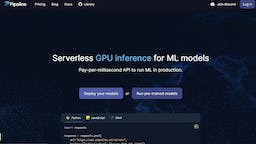User's Area

Pipeline AI
Run ML models in production with serverless GPU inference.
What is Pipeline AI?
Serverless GPU Inference for Machine Learning Models
The concept of serverless GPU inference for machine learning (ML) models aims to provide a pay-per-millisecond API that enables the efficient implementation of ML algorithms in a production environment. This approach eliminates the need for dedicated hardware infrastructure and allows for cost-effective utilization of GPU resources based on actual usage.
Advantages of Serverless GPU Inference
One of the key advantages of serverless GPU inference is its ability to enable organizations to avoid the upfront investment in expensive hardware for running ML models. By leveraging a pay-per-millisecond API, businesses can optimize their spending by only paying for the GPU resources they actually use during inference. This cost-effective model can result in significant savings over time, particularly for organizations with varying workloads that do not require constant access to GPU resources.
Furthermore, the serverless nature of GPU inference allows for greater scalability and flexibility in deploying ML models. This approach eliminates the need for managing and maintaining hardware infrastructure, reducing the operational burden on organizations. As a result, companies can more easily scale their ML workloads based on demand, without having to worry about the constraints of physical hardware.
Use Cases and Applications
Serverless GPU inference has the potential to revolutionize various industries and domains that rely on ML for decision-making and automation. In the field of autonomous vehicles, for example, the ability to perform GPU inference on a serverless platform can enhance the real-time processing of sensory data and enable faster decision-making for navigation and collision avoidance.
In the healthcare sector, serverless GPU inference can be leveraged for the rapid analysis of medical imaging data, leading to quicker and more accurate diagnosis of complex conditions. This can ultimately enhance patient care and treatment outcomes while reducing the burden on medical professionals.
Moreover, in the e-commerce industry, serverless GPU inference can power recommendation systems that analyze user behavior and preferences in real time, providing personalized product recommendations and enhancing the overall shopping experience for customers.
Considerations and Challenges
While serverless GPU inference presents numerous benefits, organizations must also consider certain challenges and limitations. One such consideration is the potential impact on latency, especially when dealing with real-time applications. Organizations need to evaluate the trade-offs between cost efficiency and the latency requirements of their specific use cases, ensuring that the chosen approach aligns with performance expectations.
Additionally, security and data privacy are critical considerations when utilizing serverless GPU inference for ML models. Organizations must implement robust security measures to protect sensitive data and ensure compliance with relevant regulations and standards. This includes implementing encryption, access controls, and regular security audits to mitigate potential vulnerabilities.
Conclusion
Serverless GPU inference offers a compelling solution for organizations seeking to leverage GPU resources for ML inference without the constraints of dedicated hardware infrastructure. By providing a pay-per-millisecond API, this approach enables cost-effective utilization of GPU resources and offers scalability, flexibility, and efficiency in deploying ML models. While certain considerations and challenges exist, the potential applications and advantages of serverless GPU inference make it a promising avenue for accelerating the adoption of machine learning in production environments.